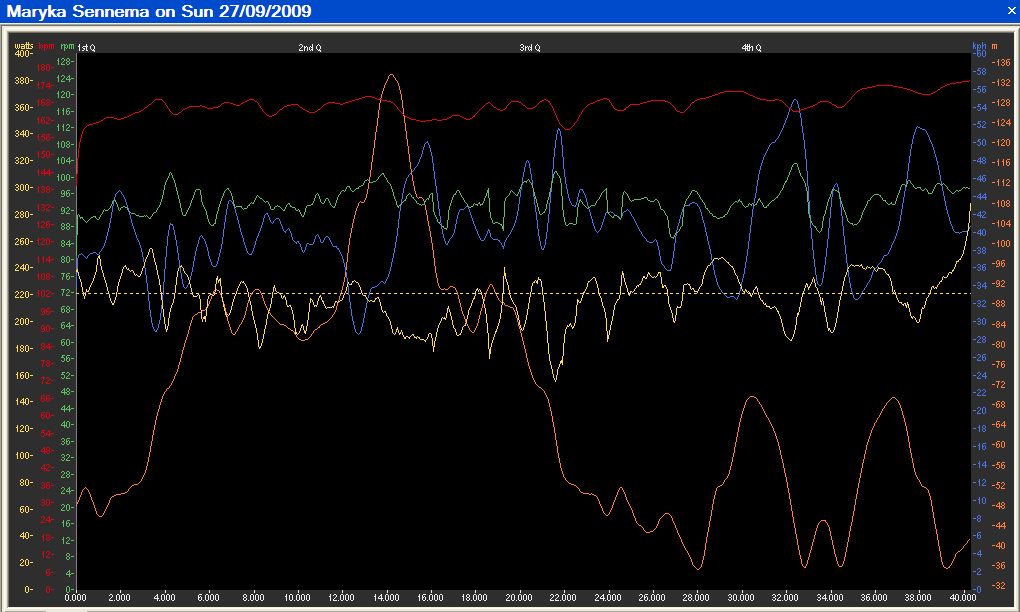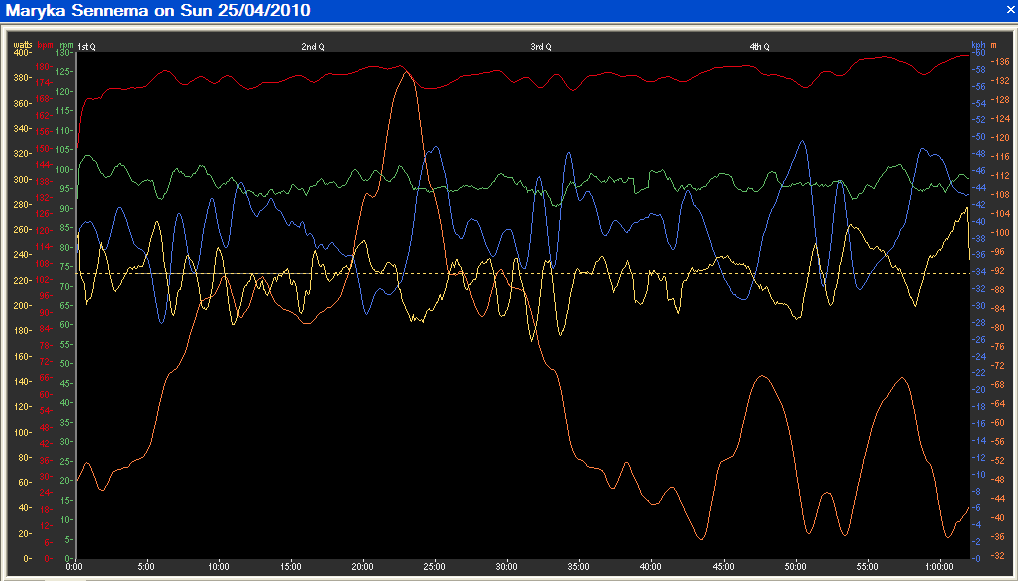I've often thought about whether this system of testing and evaluation power is really accurate for most riders, since few of us ride 60 minutes at a steady state in an all-out effort very often. Yet this magical number is how I and WKO measure my effort and fatigue from all other workouts, both short and long. I suppose it's like anything: you need to train it to be good at it, so if I actually did lots of steady-state intervals at FTP like Coggan suggests, maybe my one-hour power would reflect that. But since I don't, I've had to use other measures to figure out my FTP. And it turns out that the FTP I've been using to define my training is actually a bit lower than what I can actually put out for a 25 mile time trial.
Last autumn when I did my 25 mile TT for the first time, I had my FTP set at 240 watts. This was based on a number of races I had done, intervals I could hold in training, etc. I showed up at the TT on the knife edge of fatigue, merely a few weeks before Kona. And managed to put down a time of 1:00:49 with 221 watts normative power, 218 watts average power. A full 15 watts fewer than I "should" have been able to do! Hmm.
I don't think I overestimated my FTP too much, maybe by 5 watts or so. A few weeks earlier I had done a 10-mile TT (~105% of FTP) on 254 watts so had based my numbers in part on that. Had I been fully rested, I might have been able to hit that 240 watts, or had I been doing Olympic distance triathlon training instead of Ironman, or, or, or... anyway, suffice it to say, I let my fitness tail off after Kona and at Christmas I was back down to an estimated FTP of 220 watts, to be built back up between January and March via cyclocross, winter circuit races and a warm-weather training camp spent on the Canary Islands.
Today I showed up -- same course, same time of day, same air temperature and conditions more or less, same equipment more or less, same lack of sleep, though I was less fatigued overall -- and put down a 1:01:59 with 225 watts normative power and 223 watts average power. The rain halfway through and subsequent windier conditions probably was the biggest factor in the slower time (the winner of both races who happened to be the same guy was also 90 seconds slower), though I also wriggled around a lot and cost myself some aerodynamic advantage, having not ridden my TT bike in a while and not being entirely comfortable on it. Yet I still fell 10 watts short of my current estimated FTP, which is set at 235 watts these days and I think is pretty close to reality.
No excuses this time (apart from the wriggling), but again it leaves me wondering who out there can actually ride 60 minutes straight at a completely steady effort at their WKO-estimated FTP. Yes, I could set my FTP lower, but then all my other intervals -- particularly the shorter ones -- would be overestimated, thus inflating my IF and TSS for every other workout. So this is the flaw in WKO+ I think: basically your single biggest benchmark by which all effort is measured is somewhat impossible to actually achieve! Unless of couse you race 25 mile TTs all the time. Does anyone else have this problem?
At any rate I was pleased to see an overall increase in today's race of 5 watts over last time, meaning that my fitness is pretty much at the same place it was last September when I was peaking for Ironman Kona. And it's still April! Lots of summer racing to come. For future FTP tests I'll be more likely to go out and do a Richmond Park 3LC some nice evening. Same ~60-min effort and a lot closer to home!
Below is a graphical comparison of the September 2009 and April 2010 time trials (the grid line shows the average watts for each race). Both were paced reasonably well, both contained an obvious dip halfway through as I felt the effects of the effort, and both started out perhaps a bit strongly. Today's effort showed a better recovery and kick through the last quarter of the race, and also shows how much less fatigued my overall state was, with an average HR of nearly 10 beats higher! Otherwise, the slower speeds on the downhills show the headwind today; you'd never know I had a disc cover on there.

September 27, 2009
Lap 1 (1:00:49.15):
Duration: 1:00:49 (1:00:57)
Work: 796 kJ
TSS: 85.9 (intensity factor 0.921)
Norm Power: 221
VI: 1.01
Pw:HR: -0.28%
Pa:HR: -4.76%
Distance: 40.329 km
Elevation Gain: 412 m
Elevation Loss: 417 m
Grade: -0.0 % (-5 m)
Min Max Avg
Power: 0 389 218 watts
Heart Rate: 98 176 167 bpm
Cadence: 47 131 94 rpm
Speed: 0.3 57.4 39.8 kph
Altitude: 32 137 69 m
Crank Torque: 0 60.9 22.2 N-m

April 25, 2010
Lap 1 (1:01:58.01):
Duration: 1:01:58 (1:02:06)
Work: 828 kJ
TSS: 95 (intensity factor 0.959)
Norm Power: 225
VI: 1.01
Pw:HR: 0.75%
Pa:HR: -2.91%
Distance: 40.35 km
Elevation Gain: 417 m
Elevation Loss: 421 m
Grade: -0.0 % (-5 m)
Min Max Avg
Power: 0 656 223 watts
Heart Rate: 117 184 176 bpm
Cadence: 53 123 97 rpm
Speed: 1.4 59.1 39.1 kph
Altitude: 32 137 69 m
Crank Torque: 0 103.2 22.0 N-m

4 comments:
I think you mean the power you can sustain for an hour, because the 45 minute and 90 minute people aren't... but I think you mostly misunderstood the question.
What is the FTP? Is it what you actually did on a particular day when riding a 25 mile TT, even though you weren't fully rested, had bad conditions, were uncomfortable. Or is it what you would do on a good day, when you weren't fatigued from recent training, weren't uncomfortable on the strange bike etc.
So the question is - do you set your FTP to a 25mile TT effort, even though it likely wasn't the best you could do, both from how you felt, and suggested other data from ways of testing.
Hey Maryka, I'm glad your excellent blog is up an running again. Congrats on your marriage to Jim... Oops ya got busted for not giving Dr Andy "FTP" Coggan his props! lol.. nevermind its all good :-)
Andy,
Sorry, bad wording on my part. I understand the definition of FTP. I can and have held ~235 watts NP (my estimated FTP) in tough group rides and races where I was in a break working together solidly.
My point was that on any given day, how many people can actually ride a TT and put out their FTP at a VI of 1.01. Had I been completed rested, motivated, a gun to my head, etc. I probably could have! But I just wondered how useful a 25-mile TT is for determining an FTP versus other methods.
One of the proofs that your FTP has improved is an IF of over 1.05 for a one-hour ride under "good testing conditions" i.e., a breakaway or the like. So which one trumps the other -- the higher number in a race or the lower number in a TT?
Since FTP is the magical number by which all other training zones are calculated, and since I don't train tons of steady state at FTP, I wonder if my 25 mile TT is in fact a good indicator of what I really can do for an hour. I'd hate to be setting my training zones too low, and getting inflated TSS values from an strictly-defined FTP (25 mile TT AP) that's actually not a good representation of my fitness. That's what I was saying.
Post a Comment